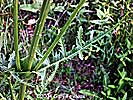
Invasive Plants of Wisconsin
| Dipsacus
laciniatus L. cut-leaved teasel Family: Dipsacaceae |
||||||
|
||||||
|
The two Wisconsin species of Dipsacus are large, spiny plants with distinctive large, stiff and spiny flowering heads that persist long after flowering is done. D. laciniatus is best identified by the stem leaves (basal leaves can be confusing) that are deeply divided, unlike those of D. fullonum that are entire, or coarsely toothed on the margins. If you are in doubt about this character look at the images of the leaves for both species and it should become clear. Flowers of D. laciniatum are frequently reported to be white on web pages (many of which are copies of copies of copies from elsewhere on the web), but I haven't found support of this in the taxonomic literature. Flowers of D. fullonum are blue (except for a rare white form). It is best to rely on the leaf characters described above. In any event, if you can be sure that the plants in question are of the Genus Dipsacus, it makes no difference which species it is --both are invasive and should be removed quickly. The stem leaves for both species are perfoliate (each pair of opposite leaves is joined at the point where they attach to the stem, giving the appearance of a single leaf pierced by the stem). The fusion of the two leaf bases at the stem forms something of a "cup" that catches and holds rain water--this seems most conspicuous on D. laciniatus. Small numbers of plants can be controlled by standard gardening techniques, i.e. pulling of small plants and digging out of the tap root of larger plants. Care must be taken to avoid injury from the impressively stiff and strong spines. Well developed flowers may still produce mature seeds if simply cut or pulled and left on the site, so flowers should be collected and destroyed or disposed of in a safe place. Larger populations can be controlled with herbicides--search on "Dipsacus management" for instructions from reliable organizations such as the Nature Conservancy. This species is clearly much more common than the map indicates. The maps are based on herbarium vouchers and these are large and spiny plants that people are not eager to collect for specimens. If you want to learn more about controlling this species the following sources may be of interest: Bentivegna D.J.2008.Integrate management of the invasive weed, cut-leaved teasel (Dipsacus laciniatus L.) along a Missouri Highways. PhD Dissertation. University of Missouri. Columbia, MO. Bentivegna D. J. 2006. Biology and Management of cut-leaved teasel (Dipsacus laciniatus L.) in central Missouri. MS Thesis. University of Missouri. Columbia,MO. 67 p. Bentivegna, D.J. and R.J. Smeda. 2008. Chemical management of cut-leaved teasel (Dipsacus laciniatus) in Missouri. Weed Technology 22:502-506. Bentivegna D.J. and Reid J. Smeda. 2011. Seed production of Cut-leaved teasel (Dipsacus laciniatus) in Central Missouri. Biologia Journal 66(5): 807-812. Bentivegna D.J. and Reid J. Smeda. 2012. Integrated management of cutleaf teasel (Dipsacus laciniatus L.) along roadsides in Missouri. International Journal of Pest Management 58 (2):147-152. |
|


